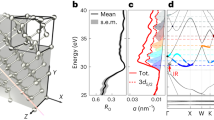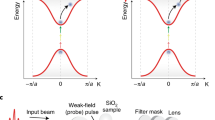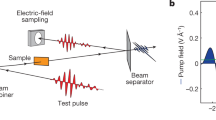Abstract
The interaction of intense infrared pulses with a solid target can initiate light-field-driven phenomena that enable the reversible manipulation of their electro-optical properties on an attosecond timescale. This interaction regime therefore offers a unique opportunity to induce and control new functionalities with very high speed. However, the efficient exploitation of coherent light–matter states for future applications requires a detailed understanding of the underlying physical processes. This task is complicated by the complex and intertwined nature of inter- and intraband dynamics of real and virtual carriers underlying field-driven phenomena in solids. Here we used attosecond transient reflection spectroscopy to investigate ultrafast virtual electron dynamics in a prototype dielectric (monocrystalline diamond) over a broad photon energy range not previously accessed. Independent calibration of the pump–probe delay axis allowed direct comparison with numerical calculations, revealing that virtual interband transitions affect the timing and adiabaticity of the crystal response, even in a regime believed to be dominated by intraband motion. By demonstrating that virtual interband transitions are indispensable for an accurate description of strong-field-induced phenomena in solids, our results constitute a relevant step towards understanding transient nonlinear optical processes, a cornerstone for the future development of information processing and petahertz electronics.
This is a preview of subscription content, access via your institution
Access options
Access Nature and 54 other Nature Portfolio journals
Get Nature+, our best-value online-access subscription
$32.99 / 30 days
cancel any time
Subscribe to this journal
Receive 12 print issues and online access
$259.00 per year
only $21.58 per issue
Buy this article
- Purchase on SpringerLink
- Instant access to full article PDF
Prices may be subject to local taxes which are calculated during checkout




Similar content being viewed by others
Data availability
The experimental data and the results of the simulations discussed in this work are available via Zenodo at https://doi.org/10.5281/zenodo.14172967 (ref. 50).
Code availability
All the custom codes used in this work are available via GitHub at https://github.com/shunsuke-sato/ARTED_noc (ref. 51).
References
de la Torre, A. et al. Colloquium: nonthermal pathways to ultrafast control in quantum materials. Rev. Mod. Phys. 93, 041002 (2021).
Borsch, M., Meierhofer, M., Huber, R. & Kira, M. Lightwave electronics in condensed matter. Nat. Rev. Mater. 8, 668–687 (2023).
Hassan, M. T. Lightwave electronics: attosecond optical switching. ACS Photonics 11, 334–338 (2024).
Hui, D. et al. Ultrafast optical switching and data encoding on synthesized light fields. Sci. Adv. 9, eadf1015 (2023).
Boolakee, T. et al. Light-field control of real and virtual charge carriers. Nature 605, 251–255 (2022).
Higuchi, T., Heide, C., Ullmann, K., Weber, H. B. & Hommelhoff, P. Light-field-driven currents in graphene. Nature 550, 224–228 (2017).
Kruchinin, S. Y., Krausz, F. & Yakovlev, V. S. Colloquium: strong-field phenomena in periodic systems. Rev. Mod. Phys. 90, 021002 (2018).
Schlaepfer, F. et al. Attosecond optical-field-enhanced carrier injection into the GaAs conduction band. Nat. Phys. 14, 560–564 (2018).
Inzani, G. et al. Field-driven attosecond charge dynamics in germanium. Nat. Photonics 17, 1059–1065 (2023).
Ossiander, M. et al. The speed limit of optoelectronics. Nat. Commun. 13, 1620 (2022).
Krausz, F. & Stockman, M. I. Attosecond metrology: from electron capture to future signal processing. Nat. Photonics 8, 205–213 (2014).
Heide, C. et al. Attosecond-fast internal photoemission. Nat. Photonics 14, 219–222 (2020).
Yablonovitch, E., Heritage, J. P., Aspnes, D. E. & Yafet, Y. Virtual photoconductivity. Phys. Rev. Lett. 63, 976–979 (1989).
Yamanishi, M. Field-induced optical nonlinearity due to virtual transitions in semiconductor quantum well structures. Phys. Rev. Lett. 59, 1014–1017 (1987).
Khurgin, J. B. Optically induced currents in dielectrics and semiconductors as a nonlinear optical effect. J. Opt. Soc. Am. B 33, C1 (2016).
Schiffrin, A. et al. Optical-field-induced current in dielectrics. Nature 493, 70–74 (2013).
Paasch-Colberg, T. et al. Sub-cycle optical control of current in a semiconductor: from the multiphoton to the tunneling regime. Optica 3, 1358–1361 (2016).
Sanari, Y. et al. Role of virtual band population for high harmonic generation in solids. Phys. Rev. B 102, 041125 (2020).
Jürgens, P. et al. Origin of strong-field-induced low-order harmonic generation in amorphous quartz. Nat. Phys. 16, 1035–1039 (2020).
Schultze, M. et al. Controlling dielectrics with the electric field of light. Nature 493, 75–78 (2013).
Lucchini, M. et al. Attosecond dynamical Franz–Keldysh effect in polycrystalline diamond. Science 353, 916–919 (2016).
Geneaux, R., Marroux, H. J. B., Guggenmos, A., Neumark, D. M. & Leone, S. R. Transient absorption spectroscopy using high harmonic generation: a review of ultrafast X-ray dynamics in molecules and solids. Philos. Trans. R. Soc. A 377, 20170463 (2019).
Di Palo, N. et al. Attosecond absorption and reflection spectroscopy of solids. APL Photonics 9, 20901 (2024).
Lucarelli, G. D. et al. Novel beamline for attosecond transient reflection spectroscopy in a sequential two-foci geometry. Rev. Sci. Instrum. 91, 053002 (2020).
Volkov, M. et al. Floquet–Bloch resonances in near-petahertz electroabsorption spectroscopy of SiO2. Phys. Rev. B 107, 184304 (2023).
Zimin, D. A. et al. Dynamic optical response of solids following 1-fs-scale photoinjection. Nature 618, 276–280 (2023).
Gruzdev, V. & Sergaeva, O. Ultrafast modification of band structure of wide-band-gap solids by ultrashort pulses of laser-driven electron oscillations. Phys. Rev. B 98, 115202 (2018).
Otobe, T., Shinohara, Y., Sato, S. A. & Yabana, K. Femtosecond time-resolved dynamical Franz–Keldysh effect. Phys. Rev. B 93, 045124 (2016).
Mairesse, Y. & Quéré, F. Frequency-resolved optical gating for complete reconstruction of attosecond bursts. Phys. Rev. A 71, 011401 (2005).
Inzani, G., Di Palo, N., Dolso, G. L., Nisoli, M. & Lucchini, M. Absolute delay calibration by analytical fitting of attosecond streaking measurements. J. Phys. Photonics 6, 025007 (2024).
Lucchini, M. et al. Attosecond timing of the dynamical Franz–Keldysh effect. J. Phys. Photonics 2, 025001 (2020).
Lucchini, M. et al. Light–matter interaction at surfaces in the spatiotemporal limit of macroscopic models. Phys. Rev. Lett. 115, 137401 (2015).
Lucchini, M. et al. Unravelling the intertwined atomic and bulk nature of localised excitons by attosecond spectroscopy. Nat. Commun. 12, 1021 (2021).
Houston, W. V. Acceleration of electrons in a crystal lattice. Phys. Rev. 57, 184–186 (1940).
Krieger, J. B. & Iafrate, G. J. Time evolution of Bloch electrons in a homogeneous electric field. Phys. Rev. B 33, 5494–5500 (1986).
Runge, E. & Gross, E. K. U. Density-functional theory for time-dependent systems. Phys. Rev. Lett. 52, 997–1000 (1984).
Hui, D. et al. Attosecond electron motion control in dielectric. Nat. Photonics 16, 33–37 (2022).
Floquet, G. Sur les équations différentielles linéaires à coefficients périodiques. Ann. Sci. Ec. Norm. Super. 12, 47–88 (1883).
Oka, T. & Kitamura, S. Floquet engineering of quantum materials. Annu. Rev. Condens. Matter Phys. 10, 387–408 (2019).
Sentef, M. A. et al. Theory of Floquet band formation and local pseudospin textures in pump-probe photoemission of graphene. Nat. Commun. 6, 7047 (2015).
Lucchini, M. et al. Controlling Floquet states on ultrashort time scales. Nat. Commun. 13, 7103 (2022).
Ito, S. et al. Build-up and dephasing of Floquet–Bloch bands on subcycle timescales. Nature 616, 696–701 (2023).
Ikeda, T. N., Tanaka, S. & Kayanuma, Y. Floquet–Landau–Zener interferometry: usefulness of the Floquet theory in pulse-laser-driven systems. Phys. Rev. Res. 4, 033075 (2022).
Reiss, H. R. Theoretical methods in quantum optics: S-matrix and Keldysh techniques for strong-field processes. Prog. Quantum Electron. 16, 1–71 (1992).
Nisoli, M., De Silvestri, S. & Svelto, O. Generation of high energy 10 fs pulses by a new pulse compression technique. Appl. Phys. Lett. 68, 2793–2795 (1996).
Mashiko, H. et al. Double optical gating of high-order harmonic generation with carrier-envelope phase stabilized lasers. Phys. Rev. Lett. 100, 103906 (2008).
Gilbertson, S., Khan, S. D., Wu, Y., Chini, M. & Chang, Z. Isolated attosecond pulse generation without the need to stabilize the carrier-envelope phase of driving lasers. Phys. Rev. Lett. 105, 093902 (2010).
Itatani, J. et al. Attosecond streak camera. Phys. Rev. Lett. 88, 173903 (2002).
Faccialà, D., Toulson, B. W. & Gessner, O. Removal of correlated background in a high-order harmonic transient absorption spectra with principal component regression. Opt. Express 29, 35135–35148 (2021).
Dolso, G. L. et al. Dataset for: Attosecond virtual charge dynamics in dielectrics. Zenodo https://doi.org/10.5281/zenodo.14172967 (2024).
Sato, S. A. ARTED_noc. GitHub https://github.com/shunsuke-sato/ARTED_noc (2024).
Acknowledgements
This project has received funding from the European Research Council (ERC) under the European Union’s Horizon 2020 research and innovation programme (grant agreement no. 848411 title AuDACE) and from MIUR FARE (grant no. R209LXZRSL, title PHorTUNA). This work utilized the computational resources of the HPC systems at the Max Planck Computing and Data Facility (MPCDF) and the Multidisciplinary Cooperative Research Program (MCRP) at the Center for Computational Sciences, University of Tsukuba.
Author information
Authors and Affiliations
Contributions
M.L., M.N. and R.B.-V. conceived the experiment. G.L.D, G.I., N.D.P. and B.M. performed the measurements and contributed to the definition of the experimental procedures. G.L.D. and M.L. evaluated and analysed the results. S.A.S. designed and performed all the simulations, including the three-band model. G.L.D., S.A.S. and M.L. defined the scientific interpretation of experimental data and calculations. All authors participated in the scientific discussion. M.L. wrote the first version of the paper, while G.L.D. and S.A.S. drafted the supplementary material. All authors contributed to the final version of the work.
Corresponding author
Ethics declarations
Competing interests
The authors declare no competing interests.
Peer review
Peer review information
Nature Photonics thanks Mohammed Hassan and the other, anonymous, reviewer(s) for their contribution to the peer review of this work.
Additional information
Publisher’s note Springer Nature remains neutral with regard to jurisdictional claims in published maps and institutional affiliations.
Supplementary information
Supplementary Information
Supplementary Figs. 1–22 and discussion.
Rights and permissions
Springer Nature or its licensor (e.g. a society or other partner) holds exclusive rights to this article under a publishing agreement with the author(s) or other rightsholder(s); author self-archiving of the accepted manuscript version of this article is solely governed by the terms of such publishing agreement and applicable law.
About this article
Cite this article
Dolso, G.L., Sato, S.A., Inzani, G. et al. Attosecond virtual charge dynamics in dielectrics. Nat. Photon. 19, 999–1005 (2025). https://doi.org/10.1038/s41566-025-01700-6
Received:
Accepted:
Published:
Issue date:
DOI: https://doi.org/10.1038/s41566-025-01700-6



